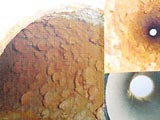Hundreds of kilometers of pipes currently used by the Thua Thien Hue Water Supply Company are 40-80 years old. Due to poor quality, they cause water turbidity, frequent pipe bursts, and leaks, resulting in both water loss and contamination within the pipes. A research team from the company has developed a cost-effective solution instead of purchasing new pipes.
 |
|
Rusty water pipes often result in significant losses. (Photo by the research team) |
Old cast iron and steel pipes without a cement lining (including galvanized pipes) degrade over time when exposed to water, particularly in the presence of residual chlorine disinfectants or when the tap water is saline. This accelerates the oxidation of the inner surface of the pipes, forming a porous rust layer that causes water turbidity and high iron content.
Additionally, these old cast iron and steel pipes typically use cement and wire mesh joints (rigid joints), which are prone to failure under external forces, such as passing vehicles or unstable ground. This often leads to widespread water loss or leaks at the joints. Turbid and contaminated water also causes meters to run slowly and fail quickly, resulting in revenue loss.
 |
|
Rusty water pipes (left) and after treatment (below, right). (Photo by the research team) |
Engineer Truong Cong Nam and his colleagues investigated and found that they could clean the inner surfaces of these pipes using high-pressure water jets. This process completely cleans the pipe’s interior, revealing the bright surface of the cast iron and steel inside.
To protect the pipe surface after cleaning, the team applies a layer of cement mortar inside the pipe using high-speed centrifugal force. After the maintenance process, the engineers coat the external surfaces of the pipes with bitumen before putting them back into service.
Finally, the research team designed a flexible coupling for pipe connections and a rubber gasket to replace the rigid joint.
This innovation has doubled the pressure resistance of the pipes (from 8 kg/cm³ to 16 kg/cm³), improved the quality of the supplied water, and reduced water loss, instead of the previous method of cutting the old pipes to install new ones. The solution also prevents external contamination from entering the pipes through leaks.
The restoration of old pipes has enabled the company to proactively replace over 90 kilometers of low-quality piping, significantly enhancing the quality of water supply in Hue and surrounding areas. The water loss rate has decreased from 26% in 2000 to below 20% as it stands today.
Overall, the solution has saved nearly 12.25 billion VND by replacing old, low-quality pipes; generated approximately 8.8 billion VND in benefits by reducing annual water loss rates compared to 2001; increased pipeline pressure; minimized the number of pipeline incidents; and made use of old, low-quality pipes.
According to Mr. Nam, this technical solution can be applied to all water supply companies nationwide, especially those with older water supply systems. The project won the second prize at the National Technical Innovation Contest in 2005.
Thuan An


















































